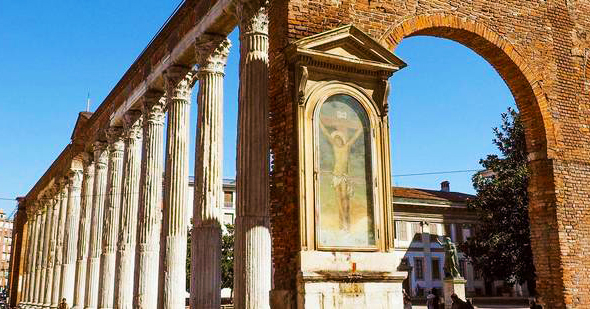This week the Publisher’s Tour ends with the final segment of the trip to the capital of Lombardia – Milan. The city has a very long history, often punctuated by invasions and wars. We would like to present a brief history of Milan to acquaint readers with this fascinating city.
According Roman history, a village was first founded in the area of Milan in the 6th century BC. It was conquered by Roman legions in 222 BC and named Mediolanum. Today, only a few traces of the Roman period remain in the city. The Columns of San Lorenzo, the ruins in Via Circo, under the Milan Stock Exchange and those in the Monastero Maggiore provide evidence that it was a major city at the time. With the subdivision of the Roman Empire in 286 AD, Milan became one of the two capitals of its Western portion. It was a very important center for the consolidation of the new Christian religion. Emperor Constantine issued the Edict of Milan in 313 AD, granting tolerance to all religions within the Empire and thus paving the way for Christianity to become the dominant religion of Roman Europe.
One of the causes of the fall of the Roman Empire was the barbaric invasions from Northern Europe and Asia. Milan was sacked in 539 AD and its role as capital was lost. After attacks by the Visigoths in 402 and Attila the Hun 50 year later, the real break with the city’s Imperial past came in 539 during the Gothic War, when the Lombards assumed control of northern Italy. They took the Roman city of Ticinum as their capital, renaming it Papia (the modern Pavia) and left early-medieval Milan to the governance of its archbishops. Two hundred years passed and then Milan was conquered by Charlemagne and the Franks. The next centuries passed under the rule of emperors from northern countries, but the area of Milan always proved to be a hotbed for political and social change.
A remarkable independence movement developed during the 11th century in northern Italy and fought against northern rule. By this point, Milan had regained its economic predominance in the region and was governed by democratic laws. The Palazzo della Ragione (Palace of Reason) was begun in 1228 as a seat for its political self-rule.
The period of democratic government came to an end when power was seized by the Visconti family who ruled Milan until 1447. The Viscontis gave the city a political and cultural supremacy which brought international renown. It is under their rule that the construction of the Duomo began. In 1450, Francesco Sforza, son-in-law of the last Visconti Duke and a captain of the Milanese army, took over command of the city. The Sforza family’s rule coincided with the Italian Renaissance and marked Milan’s moments of major artistic creativity. Among others, Leonardo da Vinci and Donato Bramante came to work for the city. It was during this period that the Castle was built, along with the hospital, which today is the State University and the church of Santa Maria delle Grazie.
In the early 16th century, northern Italy became one of the territories contested by the French and Spanish monarchies. The Spanish prevailed and the city was governed by them from 1535 to 1706. This was not a time of development. The Great Plague of Milan, 1629 – 1631, killed an estimated 60,000 people out of a population of 130,000. This episode is considered one of the last outbreaks of the centuries-long pandemic of plague that began with the Black Death.
The great European wars of the late 17th and early 18th centuries brought Milan under the domination of the Austrian Imperial dynasty of the Hapsburgs, but the city experienced a recovery which encompassed its economy, arts, culture, education and scientific development. The Brera Academy was founded in this period and La Scala Opera Theatre, Palazzo Reale and Villa Reale were built, as well as many other private palazzi. In the course of the wars that followed the French Revolution of 1789, Milan came under a relatively brief period of French control.
When the Austrians returned to Milan after Napoleon’s defeat in 1815, they were no longer enlightened reformers. In 1848, the city rebelled and in 1859 it became part of the Savoy Kingdom, which was to become, in 1861, the Kingdom of Italy.
With the unification of Italy, Milan broadened its reach for new markets and it rapidly became a financial and industrial center. Milan’s city center was soon taken over by banks and insurance companies, causing great changes in the urban landscape. Elegant residential districts were built, along with a model prison (San Vittore) and the Cimitero Monumentale.
The Fascist party was founded in Milan in 1919. With the exception of industrial workers and a few groups of intellectuals, the city itself did not oppose the birth of the dictatorship. It was during Fascism that a series of large works such as the Stazione Centrale (Central Railway Station) were built, but there were also some examples of innovative architecture; the Triennale art and design museum was one of them.
Milan was devastated by Allied bombardments during WWII and was on the front line of the partisan war against the Nazis who had occupied Italy in 1943. The city has emerged as Italy’s major center for commerce, finance, publishing and more recently, media, design and most famously – fashion.




